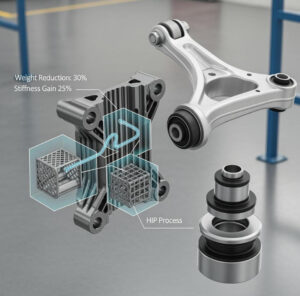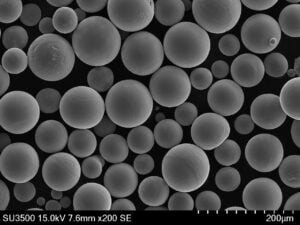Titanium Engine Mounts
Table of Contents
Introduction – The Ascent of Additive Manufacturing in Aerospace Engine Components
The aerospace industry constantly demands lighter, stronger, and more efficient components to push the boundaries of flight. Among these critical parts, the engine mount stands as a vital link, securing the powerful engines to the airframe and enduring immense stress and vibration. Traditionally manufactured through subtractive methods like machining, these components often face limitations in design complexity, material waste, and extended lead times. However, a transformative technology is reshaping the landscape of aerospace manufacturing: metal 3D printing, also known as metal additive manufacturing. This innovative approach offers unprecedented design freedom, the ability to optimize for weight reduction, and the potential for faster production cycles. At the forefront of this revolution stands Metal3DP Technology Co., LTD, a leading provider of additive manufacturing solutions committed to delivering industry-leading print volume, accuracy, and reliability for mission-critical parts like aerospace engine mounts. Their expertise in both advanced metal powders and cutting-edge 3D printing equipment positions them as a trusted partner for aerospace manufacturers seeking to leverage the benefits of metal AM.
What is a Titanium Aerospace Engine Mount Used For?
An aerospace engine mount is a structural component engineered to securely attach an aircraft engine to the airframe. Its primary functions are multifaceted and critical to the safe and efficient operation of an aircraft. Firstly, it must bear the substantial weight of the engine and transmit the immense thrust generated during all phases of flight, from takeoff to landing. Secondly, it plays a crucial role in isolating and dampening the significant vibrations produced by the engine, preventing their transmission to the airframe and ensuring passenger comfort and structural integrity. Furthermore, the engine mount must withstand extreme temperature variations, aerodynamic loads, and potential impact forces.
In the demanding aerospace sector, the material selection for engine mounts is paramount. Titanium alloys, particularly Ti-6Al-4V and its extra-low interstitial (ELI) variant, have emerged as preferred choices due to their exceptional strength-to-weight ratio, excellent corrosion resistance, and high-temperature performance. These properties are crucial for minimizing aircraft weight, enhancing fuel efficiency, and ensuring long-term reliability in harsh operational environments. The complex geometries often required for optimal load distribution and vibration damping make the manufacturing of these components challenging with conventional methods. This is where the capabilities of metal 3D printing become particularly advantageous, allowing for the creation of intricate internal structures and optimized designs that are simply not feasible with traditional manufacturing processes. To explore the diverse applications of metal 3D printing in various industries, visit Metal3DP’s Metal 3D Printing page.
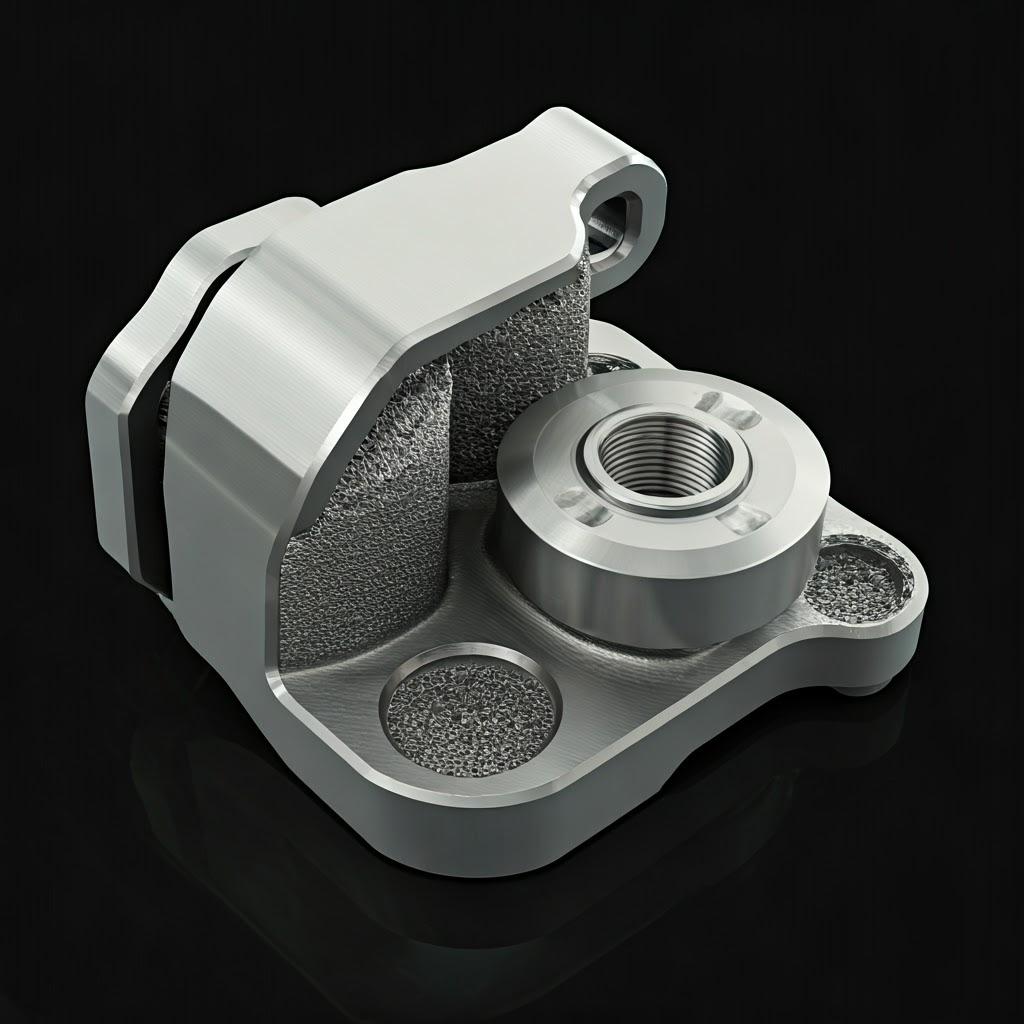
Why Use Metal 3D Printing for Titanium Engine Mounts?
The adoption of metal 3D printing for the production of titanium aerospace engine mounts presents a compelling array of advantages over traditional manufacturing techniques. These benefits directly address the critical demands of the aerospace industry, including weight reduction, performance enhancement, and streamlined production.
- Enhanced Design Freedom and Topology Optimization: Additive manufacturing liberates engineers from the design constraints imposed by traditional methods like machining or casting. Complex geometries, including internal lattices and intricate support structures, can be created, allowing for topology optimization. This process involves strategically distributing material only where it is needed for structural integrity, leading to significant weight savings without compromising strength. For aerospace engine mounts, this translates to lighter aircraft, improved fuel efficiency, and reduced emissions. Metal3DP’s printing methods, as detailed on their Printing Methods page, enable the realization of these complex designs with high precision.
- Material Efficiency and Reduced Waste: Subtractive manufacturing processes often involve removing significant amounts of material, resulting in substantial waste. Metal 3D printing, conversely, builds parts layer by layer, using only the necessary material. This near-net-shape manufacturing significantly reduces material waste, leading to cost savings, especially when working with expensive materials like titanium alloys.
- Faster Prototyping and Reduced Lead Times: Traditional manufacturing of complex aerospace components often involves lengthy tooling processes and extended lead times. Metal 3D printing allows for rapid prototyping and the production of functional parts directly from digital designs. This agility accelerates the design iteration process, enables quicker validation, and reduces the time to market for new aircraft or engine designs.
- Customization and On-Demand Manufacturing: The ability to produce customized parts on demand is another significant advantage of metal 3D printing. This is particularly beneficial for low-volume production runs, spare parts manufacturing, or the creation of tailored engine mounts for specific aircraft configurations.
- Improved Performance through Optimized Microstructures: Advanced metal 3D printing techniques can influence the microstructure of the manufactured part, potentially leading to enhanced mechanical properties such as increased strength, fatigue resistance, and durability. Metal3DP’s expertise in high-quality metal powders ensures that these optimized microstructures can be achieved consistently.
Recommended Materials and Why They Matter
For the metal 3D printing of aerospace engine mounts, titanium alloys stand out as the materials of choice due to their exceptional combination of properties. Metal3DP specializes in providing high-quality metal powders, including the recommended Ti-6Al-4V and Ti-6Al-4V ELI, specifically engineered for additive manufacturing processes.
- Ti-6Al-4V (Grade 5 Titanium): This is the most widely used titanium alloy, renowned for its high strength-to-weight ratio, excellent corrosion resistance, and good weldability. Its mechanical properties, including high tensile strength and fatigue strength, make it ideal for demanding aerospace applications like engine mounts that experience significant stress and vibration. The “6Al-4V” designation indicates its composition: approximately 6% aluminum and 4% vanadium, with the remainder being titanium. Metal3DP’s advanced powder making system ensures that their Ti-6Al-4V powder exhibits high sphericity and flowability, crucial for consistent and high-quality 3D printing. | Property | Value | Significance for Engine Mounts | | :—————————- | :————————————- | :————————————————————————————————————————————————————————————————————————————————————————————— | | Density | ~4.43 g/cm³ | Low density contributes to weight reduction, a critical factor in aerospace. | | Tensile Strength (Ultimate) | ~900-1100 MPa | High strength allows the mount to withstand significant loads and stresses during flight. | | Yield Strength | ~830-950 MPa | High yield strength ensures the mount can withstand stress without permanent deformation. | | Young’s Modulus | ~110-120 GPa | Provides stiffness necessary for maintaining structural integrity and minimizing unwanted deflections. | | Corrosion Resistance | Excellent | Ensures long-term reliability in harsh aerospace environments, resisting degradation from moisture, salt spray, and other corrosive agents. | | High-Temperature Performance | Good up to ~400°C (depending on stress) | Maintains mechanical properties at elevated temperatures encountered near the engine. |
- Ti-6Al-4V ELI (Extra-Low Interstitial, Grade 23 Titanium): This variant of Ti-6Al-4V has lower levels of interstitial elements such as oxygen, nitrogen, carbon, and hydrogen. This compositional difference results in improved ductility and fracture toughness compared to standard Ti-6Al-4V. These enhanced properties are particularly beneficial in applications requiring high fatigue resistance and resistance to crack propagation, making it an excellent choice for critical aerospace components like engine mounts that are subject to cyclic loading and potential impact. Metal3DP’s commitment to high-quality metal powders ensures that their Ti-6Al-4V ELI powder meets the stringent requirements of the aerospace industry. You can explore Metal3DP’s range of high-quality metal powders on their Product page. | Property | Value | Significance for Engine Mounts | | :—————————- | :————————————- | :————————————————————————————————————————————————————————————————————————————————————————————— | | Density | ~4.43 g/cm³ | Similar to standard Ti-6Al-4V, providing significant weight savings. | | Tensile Strength (Ultimate) | ~860-1000 MPa | Still provides high strength, although typically slightly lower than standard Ti-6Al-4V, the focus is on enhanced ductility. | | Yield Strength | ~795-900 MPa | Remains high enough for structural integrity while offering improved ductility. | | Elongation at Break | Higher than Ti-6Al-4V | Improved ductility allows the material to deform more before fracturing, enhancing its ability to withstand impact and fatigue. | | Fracture Toughness | Higher than Ti-6Al-4V | Increased resistance to crack initiation and propagation, crucial for long-term reliability in demanding aerospace applications. | | Corrosion Resistance | Excellent | Like standard Ti-6Al-4V, it offers excellent resistance to corrosion. | | High-Temperature Performance | Good up to ~400°C (depending on stress) | Maintains good performance at elevated temperatures. |
By leveraging the unique capabilities of metal 3D printing with these advanced titanium alloys, aerospace manufacturers can achieve lighter, stronger, and more durable engine mounts, contributing to overall aircraft performance and efficiency.

Design Considerations for Additive Manufacturing of Engine Mounts
Optimizing the design of aerospace engine mounts for metal 3D printing requires a shift in mindset compared to traditional manufacturing. The layer-by-layer build process offers unique opportunities and imposes specific considerations that engineers must address to achieve optimal performance, cost-effectiveness, and manufacturability.
- Topology Optimization and Generative Design: As mentioned earlier, additive manufacturing enables the creation of complex, organic shapes through topology optimization. This computational process identifies areas of low stress within a design and removes unnecessary material, resulting in lightweight yet structurally sound components. Generative design, an iterative process leveraging AI algorithms, can explore a vast design space based on specific performance requirements, material properties, and manufacturing constraints. For engine mounts, these techniques can lead to highly optimized geometries that minimize weight while maximizing stiffness and vibration damping characteristics.
- Lattice Structures and Internal Features: Metal 3D printing allows for the integration of intricate internal lattice structures within the engine mount. These structures, often impossible to create with traditional methods, can provide significant weight reduction while maintaining or even enhancing stiffness and energy absorption capabilities. Different lattice designs, such as gyroids, honeycombs, or cubic structures, can be tailored to specific load-bearing requirements and vibration frequencies. Furthermore, internal channels for cooling or wiring can be directly incorporated into the design, streamlining assembly and improving functionality.
- Orientation and Support Structures: The orientation of the engine mount during the 3D printing process significantly impacts surface finish, support material requirements, and build time. Careful consideration must be given to minimizing overhangs, which require support structures to prevent collapse during printing. Optimizing the build orientation can reduce the amount of support material needed, thereby decreasing post-processing time and material waste. Design features like self-supporting angles and strategic part orientation can mitigate these challenges.
- Wall Thickness and Ribbing: Achieving the desired strength and stiffness with minimal weight often involves careful manipulation of wall thicknesses and the incorporation of reinforcing ribs. Metal 3D printing allows for the creation of thin-walled structures with strategically placed ribs to enhance rigidity without adding excessive mass. The ability to vary wall thickness locally based on stress analysis provides another avenue for weight optimization.
- Feature Integration and Consolidation: Additive manufacturing offers the potential to consolidate multiple components into a single, complex part. For an engine mount, this could involve integrating features for attaching sensors, wiring conduits, or even incorporating damping elements directly into the design. Part consolidation reduces the number of assembly steps, minimizes potential failure points associated with fasteners, and can lead to overall cost savings and improved reliability.
Tolerance, Surface Finish, and Dimensional Accuracy in 3D Printed Engine Mounts
Achieving the required levels of tolerance, surface finish, and dimensional accuracy is paramount for aerospace engine mounts to ensure proper fit, functionality, and long-term reliability. Metal 3D printing technologies have made significant strides in these areas, but understanding the capabilities and limitations is crucial for successful implementation.
- Tolerance Capabilities: The achievable tolerances in metal 3D printing depend on various factors, including the specific printing technology (e.g., Selective Laser Melting (SLM), Electron Beam Melting (EBM)), the material being used, the part geometry, and the build parameters. Generally, tolerances in the range of ±0.1 mm to ±0.05 mm can be achieved for critical dimensions. However, tighter tolerances may require post-processing steps such as CNC machining. When selecting a metal 3D printing service provider, it is essential to inquire about their tolerance capabilities and quality control processes. Metal3DP prides itself on delivering industry-leading accuracy, ensuring that mission-critical parts meet the stringent dimensional requirements of the aerospace industry.
- Surface Finish Characteristics: The surface finish of a metal 3D printed part is typically rougher compared to machined surfaces due to the layer-by-layer build process and the partially melted powder particles on the surface. The surface roughness is influenced by factors such as powder particle size, layer thickness, and build orientation. For aerospace engine mounts, specific surface finish requirements may be necessary for interfaces with other components or for fatigue performance. Post-processing techniques like shot peening, polishing, or machining can be employed to achieve smoother surface finishes as needed.
- Dimensional Accuracy Considerations: Maintaining dimensional accuracy throughout the build process is critical. Factors such as thermal expansion and contraction of the material during printing, as well as potential warping or distortion, can affect the final dimensions of the part. Careful process control, optimized build parameters, and the use of support structures are essential for minimizing these inaccuracies. Simulation tools can also be used to predict and compensate for potential distortions.
- Inspection and Quality Control: Rigorous inspection and quality control procedures are essential to verify that 3D printed engine mounts meet the required tolerances and dimensional accuracy. Techniques such as coordinate measuring machines (CMMs), laser scanning, and non-destructive testing (NDT) methods are employed to ensure the integrity and conformity of the parts. Aerospace industry standards often mandate specific inspection protocols and documentation requirements. | Parameter | Typical Achievable Range (as-printed) | Factors Influencing Value | Post-Processing Options | Relevance to Engine Mounts | | :—————— | :———————————– | :——————————————————— | :——————————————————- | :——————————————————————————————————————————————————————————————————————————————————- | | Tolerance | ±0.05 mm to ±0.1 mm | Printing technology, material, geometry, build parameters | CNC machining, grinding | Ensures proper fit and assembly with other engine and airframe components. Critical for load transfer and vibration damping. | | Surface Roughness (Ra) | 5-20 µm | Powder size, layer thickness, build orientation | Shot peening, polishing, media blasting, machining | Affects fatigue performance and can influence the integrity of interfaces with other parts. Smoother surfaces may be required in high-stress areas. | | Dimensional Accuracy | Varies with size and complexity | Thermal distortion, shrinkage, build parameters | Stress relieving, machining, careful design for AM | Ensures the mount conforms to design specifications and integrates correctly within the engine and airframe structure. Critical for maintaining the intended structural behavior. |

Post-Processing Requirements for 3D Printed Titanium Engine Mounts
While metal 3D printing offers significant advantages in creating complex geometries, post-processing steps are often necessary to achieve the final desired properties, surface finish, and dimensional accuracy for aerospace engine mounts.
- Support Structure Removal: Support structures are often required during the printing process to prevent collapse or distortion of overhanging features. These supports need to be carefully removed after the build is complete. The method of removal depends on the support material and the part geometry. It can involve manual breaking, cutting, machining, or chemical dissolution. Minimizing the need for extensive support structures through design optimization and build orientation is crucial for reducing post-processing time and effort.
- Stress Relieving and Heat Treatment: Metal 3D printed parts can have residual stresses due to the rapid heating and cooling cycles during the build process. Stress relieving heat treatments are often performed to reduce these internal stresses, which can improve the part’s dimensional stability and mechanical properties, particularly fatigue resistance. Further heat treatments may be required to achieve the desired microstructure and mechanical properties for the specific titanium alloy being used.
- Surface Finishing: As mentioned earlier, the as-printed surface finish may not meet the requirements for certain aerospace applications. Various surface finishing techniques can be employed, including:
- Shot Peening: Improves fatigue life by introducing compressive stresses on the surface.
- Media Blasting: Used for cleaning and achieving a more uniform surface texture.
- Polishing: Reduces surface roughness for improved aesthetics or functional requirements.
- Coatings: Application of protective coatings to enhance corrosion resistance, wear resistance, or other specific properties.
- CNC Machining for Critical Features: In cases where very tight tolerances or specific surface finishes are required for critical features such as mounting holes or interfaces, CNC machining may be used as a secondary process. This hybrid manufacturing approach leverages the design freedom of 3D printing for the overall shape and the precision of machining for key functional areas.
- Inspection and Quality Assurance: Post-processing also includes thorough inspection to ensure that the final part meets all dimensional, surface finish, and material property requirements. Non-destructive testing methods like dye penetrant inspection or ultrasonic testing may be used to detect any internal flaws. | Post-Processing Step | Purpose | Relevance to Engine Mounts | | :————————– | :———————————————————————- | :——————————————————————————————————————————————————————————————————————————————————- | | Support Structure Removal | Remove temporary structures used during printing. | Necessary to obtain the final part geometry. Efficient removal is crucial for cost-effectiveness. | | Stress Relieving | Reduce internal residual stresses. | Improves dimensional stability and fatigue resistance, critical for long-term reliability under cyclic loading. | | Heat Treatment | Achieve desired microstructure and mechanical properties. | Ensures the titanium alloy meets the stringent strength, ductility, and toughness requirements for aerospace applications. | | Surface Finishing (e.g., shot peening, polishing) | Improve surface roughness, fatigue life, or aesthetics. | Can enhance fatigue performance in high-stress areas and ensure proper sealing or fit with other components. | | CNC Machining | Achieve tight tolerances and specific surface finishes on critical features. | Ensures precise fit and function at interfaces with the engine and airframe. May be required for mounting holes or bearing surfaces. | | Inspection & QA | Verify dimensional accuracy, surface finish, and material integrity. | Essential to ensure the engine mount meets all aerospace quality standards and will perform reliably in service. |
Common Challenges and How to Avoid Them in 3D Printing Titanium Engine Mounts
While metal 3D printing offers numerous advantages, certain challenges can arise during the production of complex parts like titanium aerospace engine mounts. Understanding these potential issues and implementing appropriate strategies to avoid them is crucial for successful outcomes.
- Warping and Distortion: Thermal gradients during the printing process can lead to residual stresses that cause warping or distortion of the part, especially for large or complex geometries.
- How to Avoid: Optimize part orientation to minimize stress buildup, use appropriate support structures to anchor the part to the build plate, employ stress-relieving heat treatments after printing, and consider design modifications to reduce large flat areas.
- Support Removal Difficulties: Intricately designed supports or supports fused to delicate features can be challenging and time-consuming to remove, potentially damaging the part’s surface.
- How to Avoid: Design self-supporting geometries where possible, optimize support placement and density, use breakaway support structures, and carefully select support removal techniques appropriate for the material and geometry.
- Porosity and Internal Defects: Incomplete fusion of powder particles can lead to porosity or internal voids within the printed part, compromising its mechanical strength and fatigue life.
- How to Avoid: Optimize printing parameters such as laser power, scan speed, and layer thickness; ensure high-quality metal powder with good flowability (which Metal3DP provides through their advanced powder making system); maintain a controlled printing environment; and consider hot isostatic pressing (HIP) as a post-processing step to densify the material.
- Surface Roughness Exceeding Requirements: The as-printed surface finish may not meet the stringent requirements of aerospace applications, potentially affecting fatigue performance or fit.
- How to Avoid: Optimize build parameters to minimize surface roughness, consider alternative printing technologies that offer better surface finish, and employ appropriate post-processing techniques like machining or polishing.
- Achieving Tight Tolerances: Maintaining tight dimensional accuracy can be challenging, especially for large parts with complex features.
- How to Avoid: Design parts with realistic tolerances in mind for the AM process, optimize build orientation to minimize tolerance stack-up, utilize high-accuracy 3D printing equipment (like those offered by Metal3DP), and employ post-processing machining for critical dimensions.
- Material Property Variability: Achieving consistent and predictable material properties throughout the printed part can be a challenge if process parameters are not well-controlled.
- How to Avoid: Work with experienced metal 3D printing service providers who have robust process control and quality assurance procedures, utilize high-quality and well-characterized metal powders from reputable suppliers like Metal3DP, and perform thorough material testing and validation.
By proactively addressing these potential challenges through careful design, optimized process parameters, and appropriate post-processing, aerospace manufacturers can successfully leverage the benefits of metal 3D printing for the production of high-performance titanium engine mounts.

How to Choose the Right Metal 3D Printing Service Provider for Aerospace Engine Mounts
Selecting the appropriate metal 3D printing service provider is a critical decision for aerospace companies seeking to manufacture high-performance engine mounts. The right partner will possess the necessary expertise, equipment, materials, and quality control systems to meet the stringent demands of the aerospace industry. Here are key factors to consider when evaluating potential suppliers:
- Aerospace Certifications and Quality Management Systems: Ensure the service provider holds relevant aerospace certifications such as AS9100. This certification demonstrates their commitment to quality management systems specifically designed for the aerospace industry. Inquire about their inspection processes, material traceability, and non-destructive testing capabilities. A provider with robust quality control measures is essential for ensuring the reliability and safety of critical components like engine mounts.
- Material Expertise and Range of Alloys: Verify the provider’s experience working with titanium alloys, particularly Ti-6Al-4V and Ti-6Al-4V ELI, which are commonly used for aerospace engine mounts. They should have a deep understanding of the specific processing requirements and material properties of these alloys. A provider like Metal3DP, which also manufactures its own high-quality metal powders, offers a significant advantage in terms of material knowledge and process optimization.
- Printing Technology and Equipment Capabilities: Understand the types of metal 3D printing technologies the provider utilizes (e.g., SLM, EBM). Each technology has its own strengths and limitations in terms of build size, accuracy, surface finish, and material compatibility. Ensure their equipment is well-maintained, calibrated, and capable of producing parts that meet the required specifications for your engine mount design. Metal3DP offers printers with industry-leading print volume, accuracy, and reliability, catering to the demanding needs of aerospace applications.
- Design for Additive Manufacturing (DfAM) Support: A knowledgeable service provider should offer expertise in DfAM principles. They can provide valuable guidance on optimizing your engine mount design for the additive manufacturing process, helping to reduce weight, improve performance, and enhance manufacturability. Look for a partner who can collaborate with your engineering team to leverage the full potential of metal 3D printing.
- Post-Processing Capabilities: As discussed earlier, post-processing is often necessary for 3D printed parts. Evaluate the provider’s in-house post-processing capabilities, including support removal, heat treatment, surface finishing, and CNC machining. A provider offering a comprehensive suite of services can streamline the production process and ensure consistent quality.
- Lead Times and Production Capacity: Discuss your production volume requirements and the provider’s typical lead times. Ensure they have the capacity to meet your demands without compromising quality. For critical aerospace components, reliable and predictable lead times are essential for efficient supply chain management.
- Cost Structure and Transparency: Understand the provider’s pricing model and ensure transparency in their cost breakdown. Factors influencing cost include material usage, build time, post-processing, and quality control procedures. Request detailed quotes and compare them carefully, considering the overall value and expertise offered.
- Communication and Customer Support: Effective communication and responsive customer support are crucial for a successful partnership. Choose a provider that is proactive, collaborative, and readily available to address your questions and concerns throughout the project lifecycle.
By carefully evaluating these factors, aerospace companies can select a metal 3D printing service provider that aligns with their specific needs and helps them realize the full potential of additive manufacturing for their engine mount applications. You can learn more about Metal3DP‘s capabilities and commitment to partnership on their About Us page.
Cost Factors and Lead Time for 3D Printed Titanium Engine Mounts
Understanding the factors that influence the cost and lead time for metal 3D printed titanium aerospace engine mounts is crucial for effective budgeting and project planning. These parameters can vary significantly depending on the complexity of the part, material selection, production volume, and the chosen service provider.
Cost Factors:
- Material Cost: Titanium alloys, especially aerospace-grade Ti-6Al-4V and Ti-6Al-4V ELI, are relatively expensive. The amount of material used for the part and any necessary support structures will directly impact the overall cost. Design optimization to minimize material usage is therefore essential.
- Build Time: The time it takes to print an engine mount depends on its size, complexity, and the chosen printing technology. Longer build times translate to higher machine operating costs. Factors like layer thickness and scan speed influence build time.
- Post-Processing Costs: The extent of post-processing required will affect the final cost. Support removal, heat treatment, surface finishing (e.g., machining, polishing, coating), and inspection all add to the overall expense. Complex geometries often necessitate more extensive post-processing.
- Labor Costs: The expertise required for design optimization, print setup, machine operation, post-processing, and quality control contributes to the labor costs associated with manufacturing.
- Equipment and Overhead Costs: Metal 3D printing equipment is a significant investment, and service providers factor in their overhead costs, including machine maintenance, facility expenses, and software licenses.
- Quantity and Economies of Scale: While additive manufacturing is often advantageous for low to medium volume production, producing larger quantities can sometimes lead to economies of scale, potentially reducing the per-part cost. However, this depends on the specific part and the service provider’s pricing structure.
Lead Time Factors:
- Design Complexity and Optimization: The time required for design optimization, especially for complex geometries leveraging DfAM principles, can influence the overall lead time.
- Printing Time: As mentioned earlier, the build duration is a significant component of the lead time.
- Post-Processing Time: The time required for each post-processing step (support removal, heat treatment, surface finishing, inspection) adds to the overall manufacturing timeline.
- Service Provider’s Capacity and Scheduling: The current workload and scheduling at the chosen service provider can impact lead times. It’s essential to discuss lead time expectations upfront.
- Material Availability: While Metal3DP offers a range of high-quality metal powders, the availability of specific alloys or powder batches at the service provider can sometimes affect lead times. | Factor | Impact on Cost | Impact on Lead Time | Mitigation Strategies | | :————– | :—————————————————————————— | :————————————————————————————– | :————————————————————————————————————————————————————————————————————————————————————————————————————————————– | | Material | High material cost for titanium alloys. | Generally does not directly impact lead time unless specific alloys are backordered. | Optimize designs for minimal material usage. | | Build Time | Directly proportional to cost (machine operating hours). | Directly contributes to the overall manufacturing time. | Optimize build orientation and parameters to minimize build time. | | Post-Processing | Adds to the overall manufacturing cost depending on the complexity and number of steps. | Increases the total manufacturing time. | Design for minimal post-processing. Choose appropriate surface finish requirements. | | Quantity | Per-part cost may decrease with higher volumes in some cases. | May affect scheduling and overall delivery time for large orders. | Discuss volume requirements and lead time expectations with the service provider early in the process. | | Design | Complex designs may require more engineering time, increasing upfront costs. | Complex designs may take longer to optimize for AM, potentially extending the initial phase. | Engage with service providers offering DfAM expertise early in the design process to optimize for cost and lead time. |
It is crucial to have open communication with your chosen metal 3D printing service provider to obtain accurate cost estimates and lead times based on your specific engine mount design and production requirements.
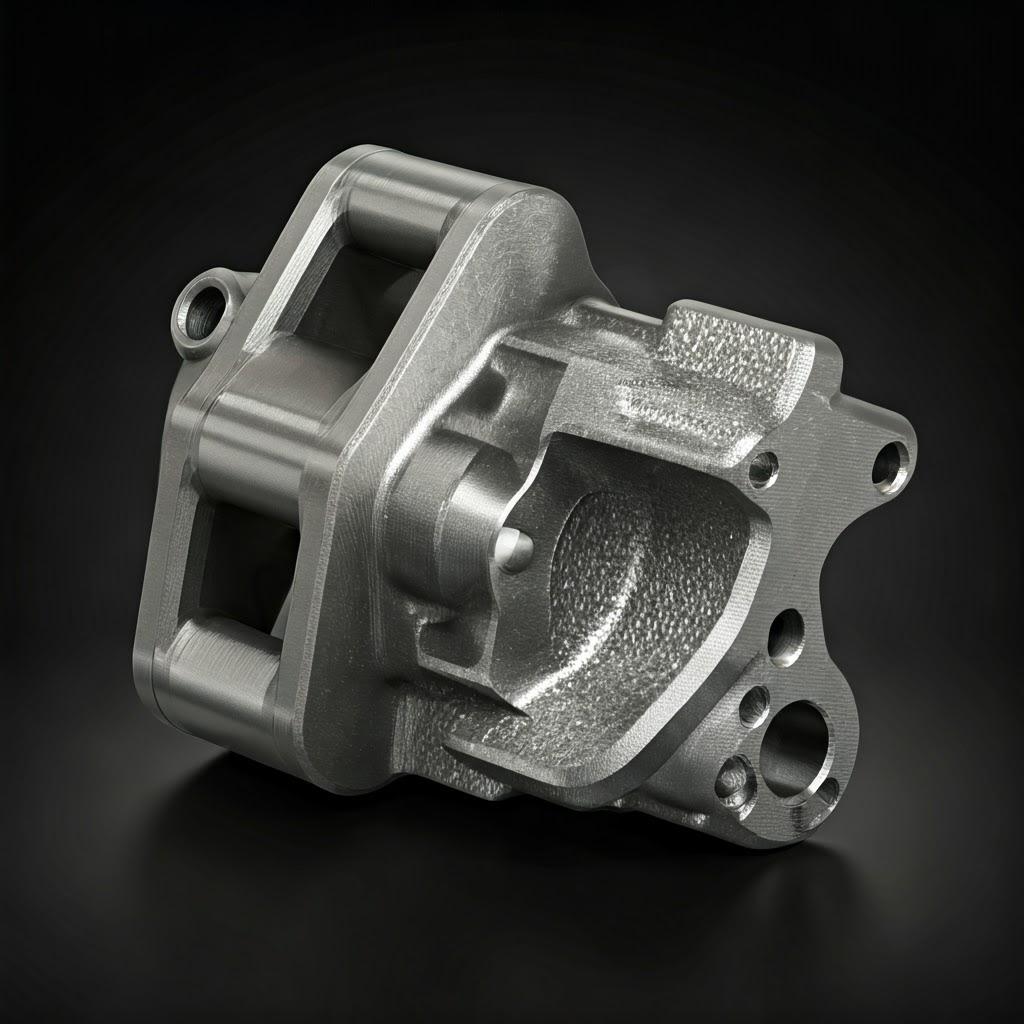
Frequently Asked Questions (FAQ)
- Can metal 3D printed titanium engine mounts meet aerospace strength requirements? Yes, when produced using high-quality metal powders like those offered by Metal3DP and with optimized printing parameters and appropriate post-processing (including heat treatment), 3D printed titanium alloys such as Ti-6Al-4V and Ti-6Al-4V ELI can meet or even exceed the strength requirements for aerospace engine mounts. Rigorous testing and quality control are essential to verify these properties.
- What are the typical tolerances achievable for 3D printed titanium engine mounts? Typical as-printed tolerances range from ±0.05 mm to ±0.1 mm, depending on the printing technology, part geometry, and build parameters. Tighter tolerances can be achieved through post-processing steps like CNC machining on critical features. Metal3DP focuses on delivering high accuracy in their printing processes.
- Is metal 3D printing cost-effective for producing aerospace engine mounts? The cost-effectiveness of metal 3D printing for engine mounts depends on factors such as production volume, design complexity, material costs, and post-processing requirements. For low to medium volume production of complex, optimized designs, it can offer significant advantages in terms of weight reduction, performance enhancement, and reduced lead times compared to traditional methods. For very high volumes, traditional manufacturing methods may still be more cost-effective.
- What are the common post-processing steps for 3D printed titanium engine mounts? Common post-processing steps include support structure removal, stress relieving and other heat treatments, surface finishing (e.g., shot peening, polishing), and potentially CNC machining for critical features requiring tight tolerances.
- How does metal 3D printing contribute to weight reduction in aerospace engine mounts? Metal 3D printing enables the creation of complex geometries, including internal lattice structures and topology-optimized designs, which strategically place material only where it is needed for structural integrity. This results in significant weight savings compared to traditionally manufactured parts that often have uniform or less optimized material distribution.
Conclusion – Powering Aerospace Innovation with Additive Manufacturing
Metal 3D printing, particularly with high-performance titanium alloys like Ti-6Al-4V and Ti-6Al-4V ELI, is revolutionizing the design and manufacturing of aerospace engine mounts. This advanced technology offers unparalleled design freedom, enabling the creation of lightweight, high-strength components with optimized geometries and enhanced performance characteristics. Companies like Metal3DP are at the forefront of this innovation, providing industry-leading 3D printing equipment and high-quality metal powders that empower aerospace manufacturers to push the boundaries of aircraft design and efficiency.
By embracing metal additive manufacturing, the aerospace industry can achieve significant benefits, including reduced weight leading to improved fuel efficiency, faster prototyping and development cycles, and the ability to produce customized parts on demand. While challenges such as achieving tight tolerances and managing post-processing requirements exist, working with experienced and knowledgeable partners like Metal3DP can help navigate these complexities and unlock the full potential of this transformative technology. As the demand for lighter, more efficient, and sustainable aircraft continues to grow, metal 3D printing will undoubtedly play an increasingly crucial role in shaping the future of aerospace manufacturing. Contact Metal3DP today to explore how their comprehensive additive manufacturing solutions can power your organization’s aerospace goals.
Share On
MET3DP Technology Co., LTD is a leading provider of additive manufacturing solutions headquartered in Qingdao, China. Our company specializes in 3D printing equipment and high-performance metal powders for industrial applications.
Inquiry to get best price and customized Solution for your business!
Related Articles
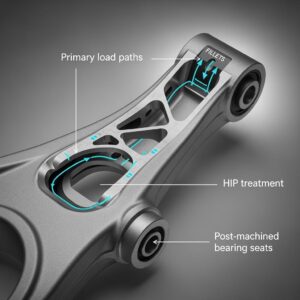
Metal 3D Printing for U.S. Automotive Lightweight Structural Brackets and Suspension Components
Read More »About Met3DP
Recent Update
Our Product
CONTACT US
Any questions? Send us message now! We’ll serve your request with a whole team after receiving your message.







